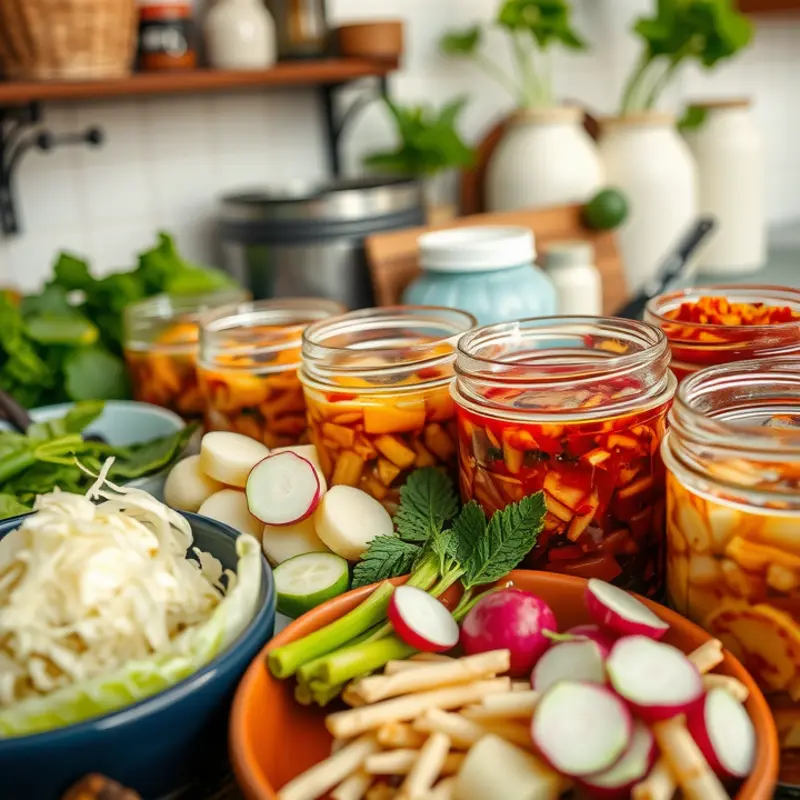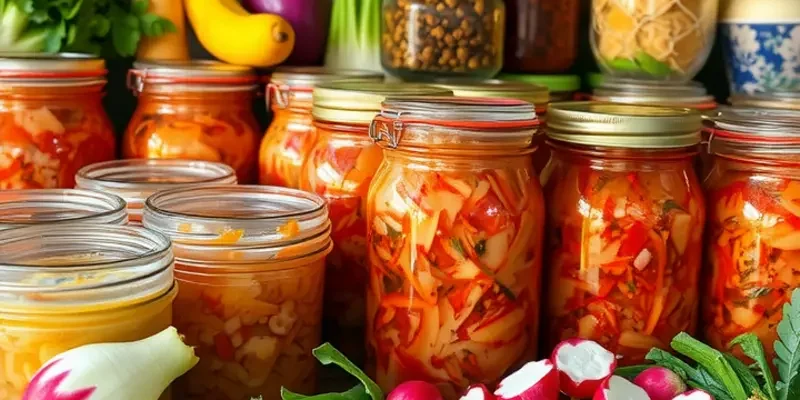Food preservation has been a vital aspect of human survival, influencing culinary practices across cultures. From fermentation in Asia to drying fruits in Africa, these ancient techniques ensured nourishment, flavor, and safety long before the era of refrigeration. As food enthusiasts and culturally-curious readers dive into the world of ancient preservation methods, they will discover the rich tapestry of traditions that not only provided sustenance but also fostered community and innovation in culinary arts.
Fermentation: The Alchemy of Flavor

Fermentation is a time-honored technique that not only preserves food but also enhances its nutritional and sensory qualities. This process involves the conversion of sugars and carbohydrates into alcohol or acids by bacteria, yeasts, or other microorganisms under anaerobic conditions. For centuries, cultures around the world have utilized this natural transformation to create foods with complex flavors.
The science behind fermentation is simple yet profound. Microorganisms break down food components, producing by-products like lactic acid, which acts as a natural preservative. This not only helps inhibit the growth of spoilage-causing organisms but also contributes to the unique taste and aroma profiles associated with fermented foods.
One cannot explore fermentation without highlighting its role in different culinary traditions. In Korea, for instance, kimchi is more than just a side dish; it is a staple that symbolizes the heart of Korean cuisine. The preparation of kimchi, primarily made from napa cabbage and radishes, involves a meticulous process. It typically includes salting the vegetables, mixing them with spices, and allowing them to ferment for several days. The result is a spicy, tangy, and umami-rich delicacy.
Similarly, in Germany, sauerkraut provides a quintessential example of fermentation. Made by fermenting finely cut cabbage with lactic acid bacteria, sauerkraut offers a crunchy texture and a sour flavor. It complements various dishes and boasts potential health benefits due to its probiotic content, which aids digestion and boosts the immune system.
The benefits of consuming fermented foods extend beyond flavor. They are rich in probiotics, or “good” bacteria, which foster a healthy gut microbiome. This connection to gut health is increasingly recognized, as it affects overall well-being, immune function, and even mental health. For those exploring non-dairy probiotic sources, ferments like kimchi and sauerkraut can be valuable additions. Detailed guides on non-dairy probiotics can be found here.
Across different regions, people have ingeniously used local ingredients to create fermented treasures unique to their climate and culture. In Japan, soybeans are transformed into miso and soy sauce, both central to Japanese cuisine. Miso itself is a popular seasoning created by fermenting soybeans with salt and a mold called koji. Its savory, umami essence amplifies everything from soups to marinades.
The global diversity of fermented foods showcases not only a culinary skill but a profound understanding of microbiology long before the science itself was formalized. Each bite of a fermented dish connects us to ancient traditions and our ancestors’ ingenuity in food preservation, flavor enrichment, and health enhancement. As we continue to explore these fermented gems from around the world, we preserve a crucial part of our culinary history, allowing us to savor not only the past but a plethora of flavors that inspire future gastronomic adventures.
Drying: The Time-Tested Technique

Drying food is a method as ancient as cooking itself, utilizing the power of the sun and wind to preserve the bounty of harvest. By removing moisture, it creates inhospitable conditions for microbial growth, effectively extending the shelf life of various foods. This practice has permeated cultures worldwide, each adapting the method to their local environment and culinary traditions. Among the most renowned examples are sun-dried tomatoes from Italy, a staple in Mediterranean cuisine. These tomatoes concentrate their natural sugars and acids after being laid out under the southern European sun, resulting in an intense burst of flavor that tells a story of sun-drenched fields and culinary passion.
In similar spirit, South Africa’s biltong showcases how drying transcends mere preservation, turning into a revered culinary art. Originally developed by indigenous people and later perfected by European settlers, biltong is crafted by air-drying strips of spiced meat. The process not only extends its edibility but also enhances its flavor profile, offering a chewy, savory taste deeply rooted in South African food culture. This tradition highlights the intimate connection between food practices and their geographical contexts, where the dry climate naturally facilitates these preservation processes.
Across Asia, drying has myriad manifestations. Thailand, for instance, is known for its sun-dried squids and fish, often seen hanging in rows along coastal areas, capturing the fresh sea breeze. This not only serves as a practical way to store these abundant resources but also locks in a profound umami flavor, critical for the characteristic taste of many Thai dishes. Such practices reveal the ingenuity of using local elements—be it the sun’s heat or coastal winds—to bolster food security and enrich culinary experiences.
The technique of drying extends beyond mere necessity or resourcefulness, becoming a means to develop unique textures and tastes. For example, dried fruits like apricots and figs were cherished in ancient trade routes, prized for their portability and concentrated sweetness. These served as early flavor boosters, much like modern culinary techniques discussed in articles like Flavor Boosters Without Salt, emphasizing enhancing foods naturally.
Such preservation methods also embody stories of their cultural landscapes and eras. For instance, in the American Southwest, Native American tribes like the Pueblo utilized drying extensively. Corn was hung in intricately tied strings, and meat was cured into jerky, not merely for survival but as part of communal harvest cycles. This preserved bounty was essential through cold winters and was central to communal rituals, reflecting an integrated approach to subsistence and tradition.
In essence, drying has endured through centuries because it merges utility with cultural expression. It is a testament to human resilience and adaptability, transforming perishable ingredients into preserved artifacts filled with flavor and history. As we explore further into other techniques, the enduring legacy of drying reminds us of its vital role in shaping the culinary tapestry across civilizations.
Final words
The legacy of ancient food preservation techniques continues to impact our culinary landscape today. By embracing methods like fermentation and drying, we not only connect with our cultural heritage but also enhance the flavors and health benefits of our food. As we explore the stories and traditions behind these practices, we foster a deeper understanding of global cuisines and the creativity that has emerged from necessity. Preserving the past allows us to savor the present while looking forward to the future of culinary innovation.








